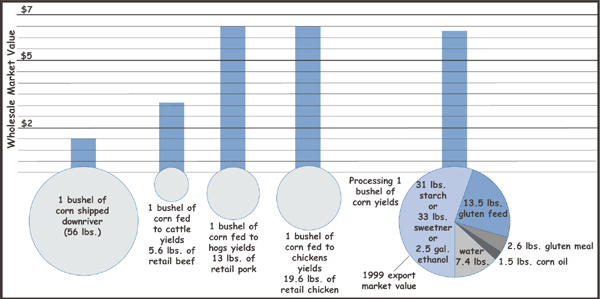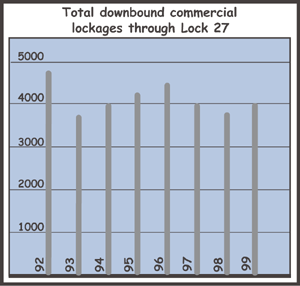|
Ship It or
Process It By Reggie McLeod and Joshua Wolfe |
The vast majority of corn grown in the Midwest is fed to livestock. The majority of the barges being pushed down the Mississippi and Illinois rivers are filled with corn destined for export from the Port of New Orleans.
The Army Corps of Engineers’ $57-million Upper Mississippi River-Illinois Waterway System Navigation Study seeks to improve shipping on the two rivers without asking whether it might be better to process the corn near the communities where it is grown, which would create jobs, add value to the crop and reduce the volume of the product. The chart below compares the volumes and wholesale values of various corn products.
| Big River Calendar of Upper Mississippi Events |
| Subscribe to Big River |
| Big River Home Page |
| contact us |

 The Corps’ study, which began in 1993, predicted that barge traffic would increase by 1.5 percent a year. This graph charts the changes in barge traffic at Lock and Dam 27 (near St. Louis).
The Corps’ study, which began in 1993, predicted that barge traffic would increase by 1.5 percent a year. This graph charts the changes in barge traffic at Lock and Dam 27 (near St. Louis).
Sources:
- Army Corps of Engineers, St. Louis District
- National Corn Growers Association
- National Geographic, “The Golden Grain: Corn,” Robert E. Rhoades, June 1993.
- United States Department of Agriculture Economics and Statistics System, Albert R. Mann Library, Cornell University
Reggie McLeod is editor and publisher of Big River, an independent magazine about the Upper Mississippi River.
Copyright 2000, Big River
|
|
|
|
|
||||||
You can find Big River on newsstands and bookstores along the Upper Mississippi in Minnesota, Wisconsin, Iowa and Ilinois. Or, you can save money and become a subscriber to Big River - the magazine for people who work, live or play on the Upper Mississippi.